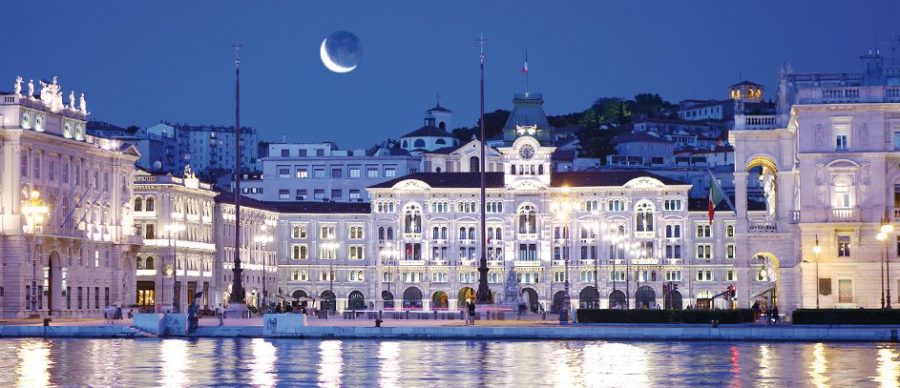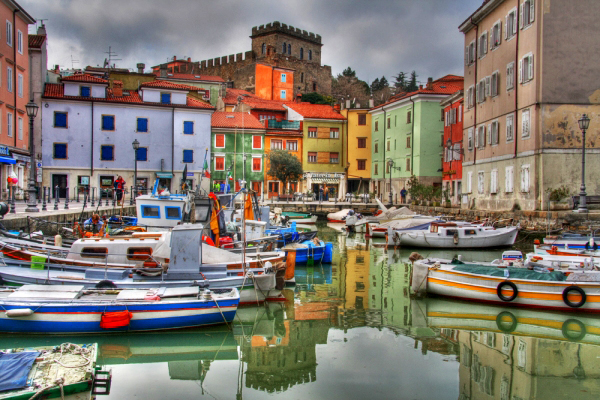Cosmopolitan and elegant, Trieste has always been a land of cultural contamination and a crossroads between Central Europe and the Mediterranean.
City of the bura that electrifies and leaves you breathless and of cafes, which fascinate with their retro atmosphere. City with a peculiar historical identity, frequented and loved in the past by poets and writers, such as Jamece Joyce, Italo Svevo and Umberto Saba who defined it as “thoughtful and shy”.
A cosmopolitan and elegant area, made up of magnificent landscapes and a slightly retro atmosphere

The tour in the Julian capital can only start from the so-called "living room of Trieste ", or Piazza Unità d'Italia, the largest square in Europe overlooking the sea. It is graced by a row of sumptuous buildings, such as the Palace of the Austrian Lieutenancy, now the seat of the Prefecture e Stratti Palace with the historian Coffee of Mirrors.
Symbolic places of the city of Trieste
Il Molo Audace it is another symbol of the city. Long and narrow strip of stone suspended in the water, from which to enjoy an incomparable view of the city and amazing sunsets over the sea.
Ma Trieste also amazes from the top of the Colle San Giusto, dominated by the castle and the homonymous cathedral, whose history is as long as that of the city. Or again, from the top of the nineteenth-century Miramare Castle, built by the will of Archduke Ferdinand Maximilian of Habsburg to live there together with his wife Charlotte of Belgium. With its luxuriant park on the tip of the Grignano promontory, it is the first fascinating glance that you have upon entering Trieste, along the panoramic coastal road.
The picturesque Bay of Muggia

La Bay of Muggia it is the great protagonist of the Trieste landscape and history. Here the sea is lived all year round, between relaxation in the "baths" of the Riviera and strolls along the many beaches of the gulf.
To immerse yourself in the special atmosphere of a seaside village, just move a few kilometers east, close to the Slovenian border, where Muggia is located. Arriving in its characteristic port, it almost seems to be among the streets and squares of a small Venice, but without canals. Here not only the architecture, but also the dialect, customs and gastronomic traditions testify to ancient links with the Serenissima.
Along the Rilke trail
On the other side of the gulf of Trieste, compared to Muggia, is the town of Duino, famous for its majestic castle built on a karst rock overlooking the sea. Dating back to 1389, over the centuries it has hosted illustrious personalities such as Franz Liszt, Gabriele d'Annunzio, Mark Twain and Reiner Maria Rilke, who composed the Duino Elegies here and to whom the magnificent panoramic path that leads to the Sistiana bay is named. . It is immersed in the Duino Cliffs Nature Reserve, in a setting interspersed with woods and white limestone ridges.
Trieste: between historic cafes and osmize

A Trieste the coffee ritual has distant roots. Already in the 700s the Julian capital was a free port for the importation of coffee. The roasting activities contribute to spreading the consumption, so much so that Trieste is among the first European cities to give life to "coffee shops", which in a short time become favorite meeting places to meet and entertain.
From the Tommaseo, overlooking the sea, to the renowned Caffè degli Specchi, passing through the elegant Caffè San Marco, the historic cafes of Trieste represent one of the souls of the city, attracting citizens and tourists with their relaxed and timeless atmosphere.
In short, in Trieste, coffee is a serious matter and its intense aroma is breathed in the air. The bond with this drink is so strong that a special lexicon has even been coined. To order an espresso in Trieste you have to ask for a "black". The stained one, on the other hand, is called "boss".
Rural aperitif
With a rustic and straightforward climate, usually family-run, the osmize they are not restaurants, or taverns and not even farmhouses. But meeting and refreshment places typical of the Karst Plateau.
It is possible to consume and buy only food (cheeses, salami, eggs, vegetables, sweets, bread) and drinks (wines and spirits) produced by the same managers, who for a few weeks open their houses and gardens, offering their products in tasting.
In the province of Trieste, mostly in the Karst area, there are about 50 osmize, many of which are framed by beautiful landscapes.





